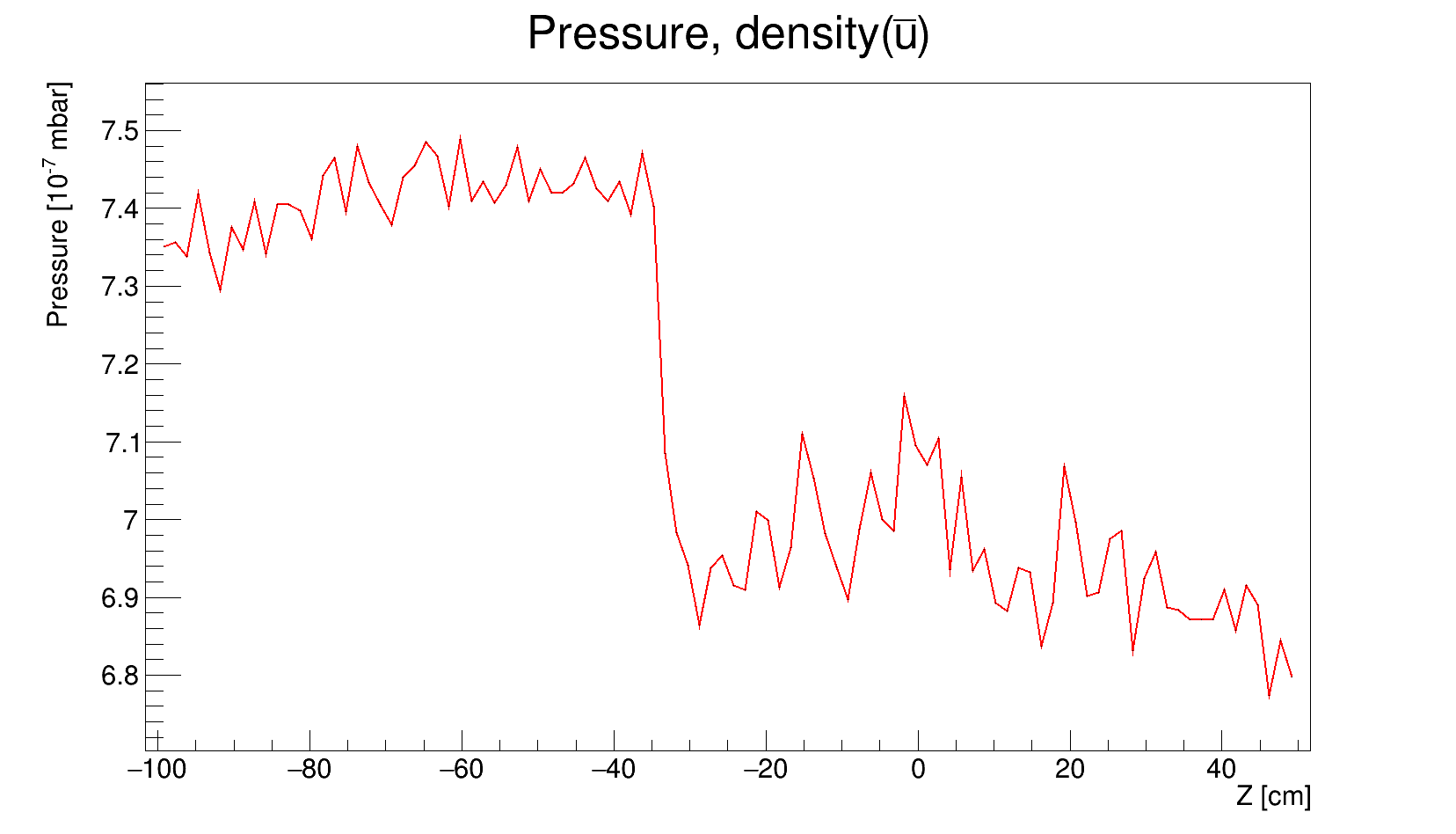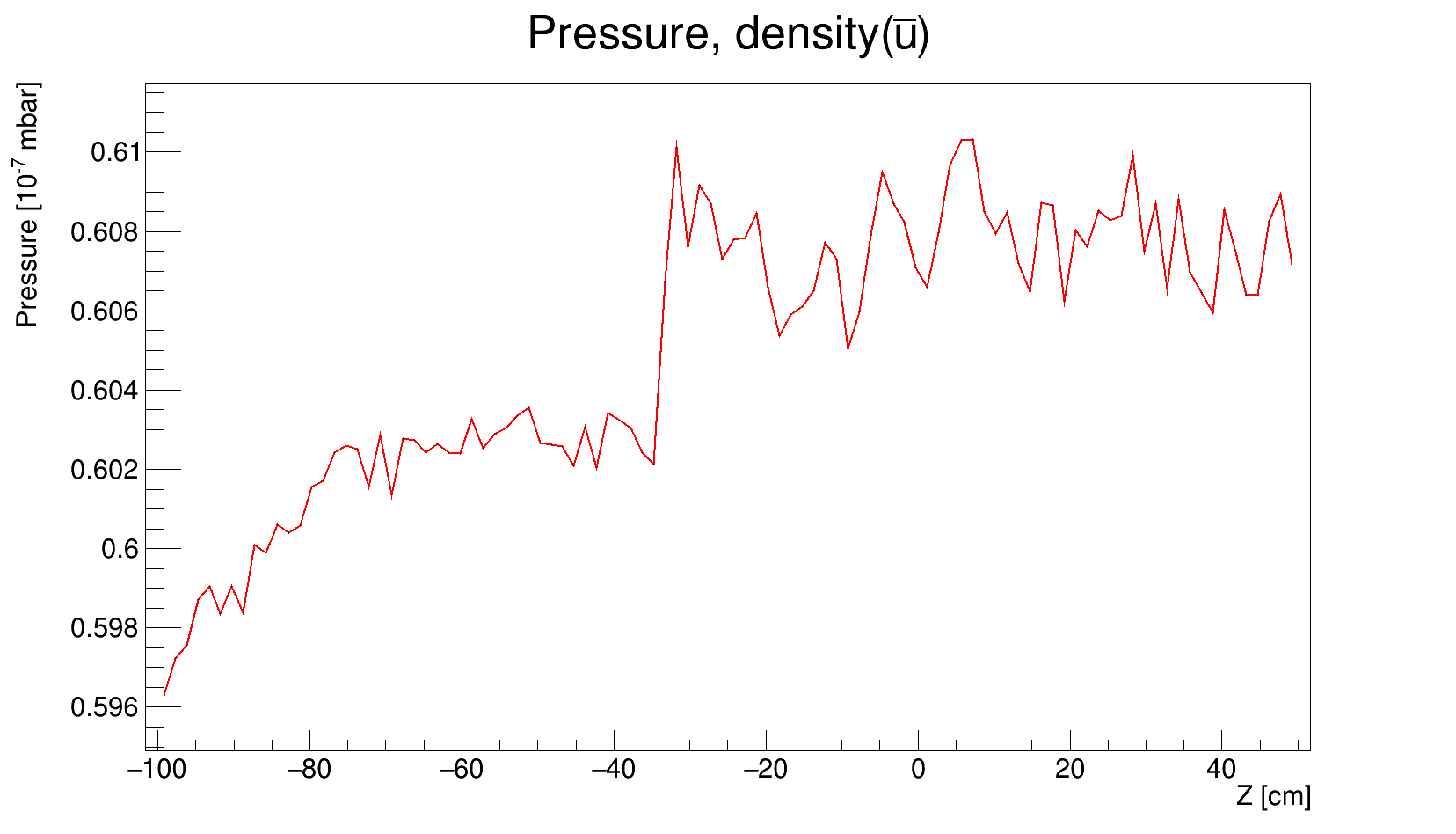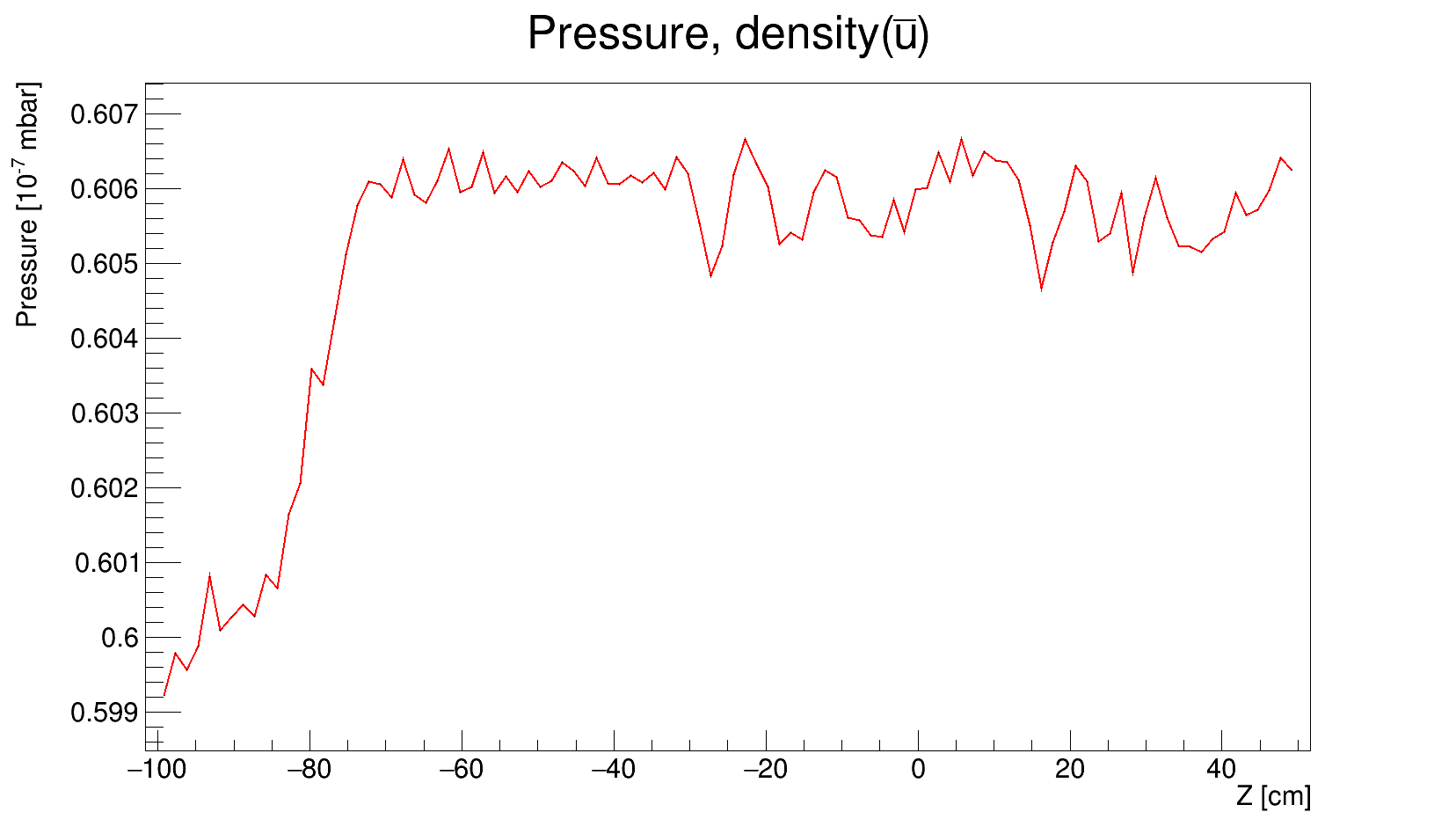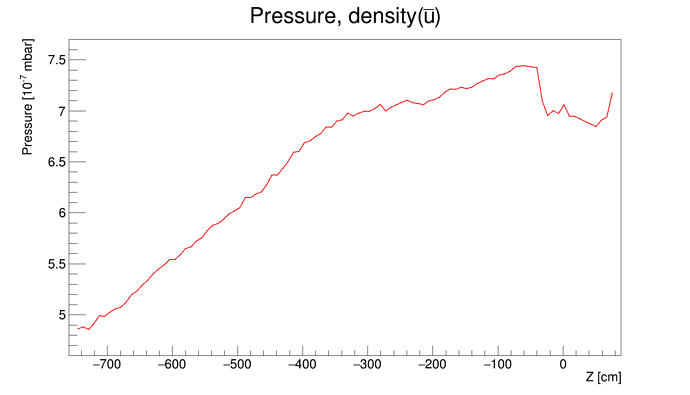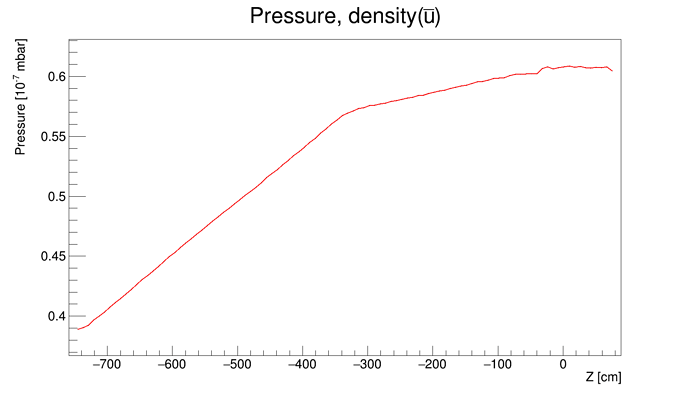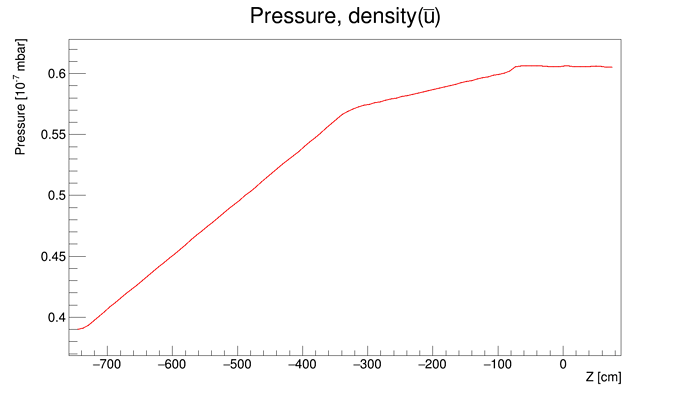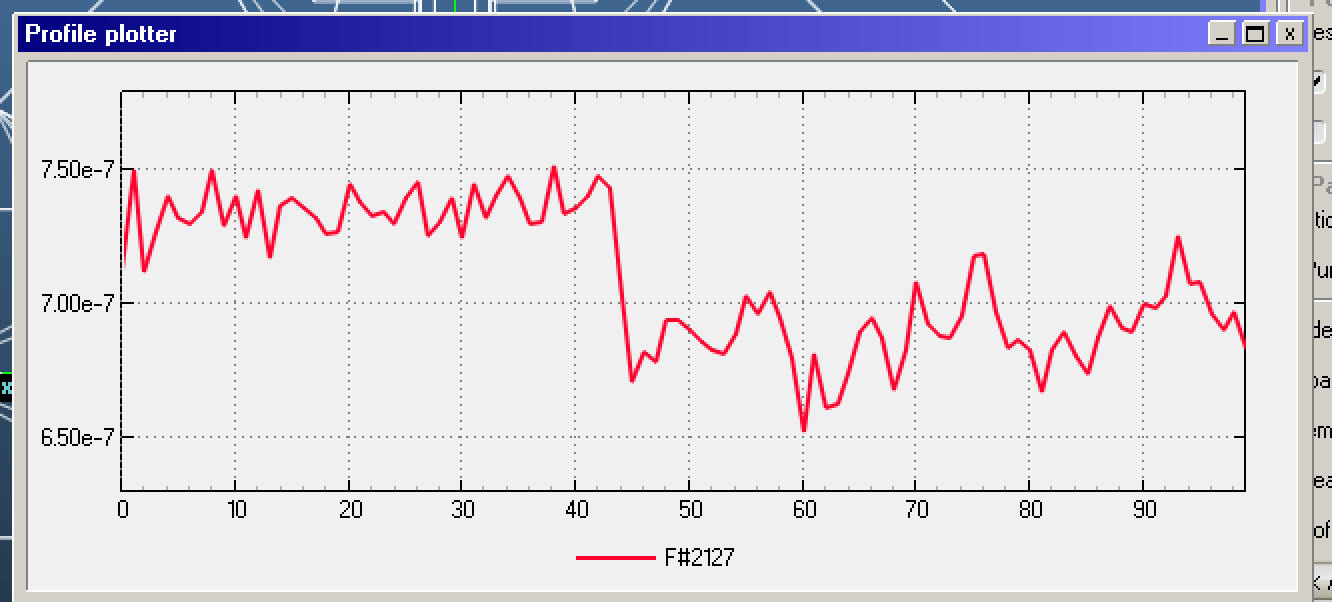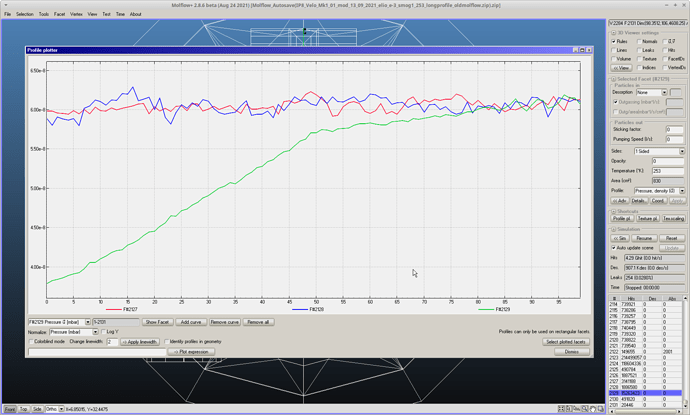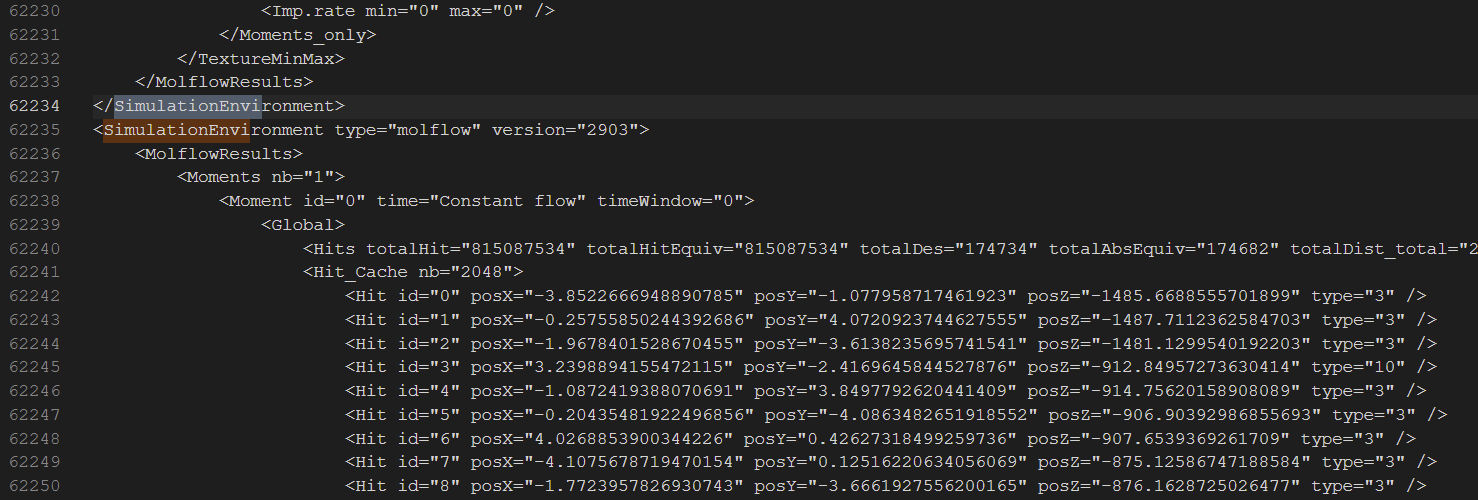Hello,
During september I run some simulations using molflow 2.8.5 in order to study the pressure profile on a transparent facet in the middle of my geometry. In all different conditions I observed a jumped in the pressure profile at a certaint position, always the same. Since it didn’t depend on the temperature of the facets, on the outgassing or on the gas species, I thought it was due to the geometry.
Now I’m running the same simulation on molflow 2.9.2, using the same geometry, conditions and running time, but that particular profile feature cannot be reproduced; I’ve tried multiple times, even running for longer, but it just doesn’t appear. I also tried to start from the september simulation without resetting, but the result is that the jump slowly desappears after long enough, while previously it just became more defined with time. I don’t understand what’s going on or if it was an unphysical effect, that I don’t know what could have caused.
Different simulation results with same geometry and conditions using molflow 2.8.5 and molflow 2.9.2
Dear Chiara,
I’m sorry that you are having trouble with the latest release of Molflow. Unfortunately we experienced a few other reports concerning the results with the latest release, which are currently investigated and fixed in an upcoming release which will hopefully follow in a few days. For the mean time, we propose to use Molflow 2.8.5.
Now for your problem, Could you share some more details concerning the test case you are using?
You are saying that it is likely not a problem with any of the settings concerning the temperature, etc. Are there any particular traits your geometry is using? E.g. Teleport facets? Time-dependence?
Could you verify, whether the other profile types are giving you reproducible results? E.g. impingement rate?
Further, if you could tell me which operating system you are using, I’ll provide you with a development release, that you could try out in the mean time to verify whether the issue persists.
Thanks for the report and we will surely get the issue solved.
Sorry for replying so late. I re-checked everything and the problem persists but I realized that in the original version I was using molflow 2.8.6, according to the xml geometry file, and not 2.8.5. Now, I have three different results.
Molflow 2.8.5
Molflow 2.8.6
Molflow 2.9.2
I’m simulating a geometry where the gas flows from a bigger pipe to a smaller one and I’m using some transparent facets to check the pressure profile along the two pipes; in order to be sure to use always the same settings, I’m loading the same geometry in the different versions of molflow, reset the simulation, and restarting it.There are no teleport facets or time-dependences. I’ve checked also the density profile and the impingement rate but they all show the same problem. I’m running the simulation on Ubuntu 20.04.
Hey Chiara,
thanks for sharing more details. Just to make sure, the actual Profile you shared for Molflow 2.8.5, is it actually from the same facet? I’m wondering because the profile is completely different, having a drop instead of a rise of pressure and a magniture difference by a factor of 10.
Yes, it’s from the same facet, and that surprised me too. I can share the geometry I’m using if that can help
That would be great and help tremendously in urgently verifying and fixing the issue.
So in case the geometry is not confidential, you can forward it directly to me via pascal.baehr@cern.ch
Hello everybody: It has happened to me in the past that the same facet with different versions of the code had profiles flipped around, like in this case. It depends how the facets’ (u,v) axis are defined… check that, please.
Also, if you could share the molflow+ file that would help us a lot (confidentiality assured, of course…).
Cheers/ciao.
Hello, I thought about the (u,v) axis too but they are defined in the same way. I also double checked that using a second transparent facet that spans a longer section and the features are still the same.
Yesterday I sent the molflow+ file to pascal.baehr@cern.ch but I can share them here too if you prefer.
Thanks for the help
Hey Chiara,
thanks for sharing the files. That really helps us a lot. And I can internally distribute them for that matter if it’s okay.
I was already looking a bit into the issue. So far I could only validate the results on a macOS machine, where I am not able to reproduce the different results. All results look just like your profiles that you did with Molflow 2.9.2. I will double check on my Ubuntu development machine later and see if this could be something OS dependent.
This is the profile I got with 2.8.5:
Hello:
I’m running 2.8.6 May26 version and the 3 profiles along facets #2127, 2128, and 2129 look OK to me…
I rerun it again in 2.8.6 (I’ve got the August 24 version) and I keep getting the same results, especially I get a pressure that’s a order of magnitude lower than that from 2.8.5 and 2.8.6(may26).
At this point, should I consider invalid the results previously obtained and rerun everything only with 2.8.5?
Hey Chiara,
finally I understand the situation. To clarify:
Molflow 2.8.6 (beta), which was shared only internally, was the predecessor to Molflow 2.9. It was the inofficial version that first incorporated the major architectural changes.
So from Molflow 2.8.6 (beta) up to – including – 2.9.2 there has been a critical bug giving wrong physical results for profiles. This is already fixed in the release candidate for Molflow 2.9.3, which you can download from here (Download for Ubuntu).
The versions that should give you the correct results are therefore Molflow 2.8.5 and the upcoming 2.9.3 beta release.
If it’s possible, could you please verify whether the 2.9.3 release gives you indeed the correct results?
Sorry for the trouble!
Wait a second,… one order of magnitude is HUGE!.. we need to understand what’s going on here, before you use the wrong results.
I have closed the two slots above/below of the tube in the center of the system, and made generation from one internal facet only (removing the original desorption facet). If I ran 2.8.6 and 2.9.2 I get 1 order of magnitude difference.
I then deleted everything except the tube and re-run it with the two versions and I get exactly the same results.
It is as if one of the two versions wouldn’t index the pressure profiles correctly, which could explain the different shape of the curves too. I have the impression that 2.8.6 is correct, and 2.9.2 is not… but I need to look at it further.
This is very strange, and it may take a while to debug. Please wait, Chiara!
I tested the new version and I can confirm that now it gives the same results as in the 2.8.5. However, I found a couple of bugs. The GUI version crashes (segmentation fault) when I try to load a geometry, so I ran the simulation through molflowCLI. MolflowCLI, on the other hand, generates a xml file that can’t be read correctly because it contains repetition of the root (First, there is the input xml file and than multiple repetition of before each repetition of , for example, in this case, I had 7 repetitions). I manually separated each , so I could check the results, but it would be a problem if I would use it in a script.
And it goes on like this multiple times
Aside from that, thank you so much for the help and the fast response to my problem, it really helped a lot.
Thanks again for your prompt reply. I encountered the bug with the repetitive branches before and I believed it was fixed for most scenarios. Before we publish the official 2.9.3 beta this will be fixed.
Also, could you elaborate the crash you are encountering a bit more? Does it crash when loading any geometry or only for a particular one? If you launch molflow from within the terminal, do you have further informations besides the segmentation fault error? On my Ubuntu test machine it behaves normally, hence I’m asking.
Sorry again for the inconvience.
It crashes both when I load a geometry from outside (I tried with different geometries, both xml and zip) and when I create a test pipe directly from molflow, but it gives no problem if I create new facets in an empty geometry; the terminal only gives the Segmentation fault (core dumped) error. I’m sorry I can’t give more information about this.
I could quickly identify this problem and apply a fix.
It was a particular bug for Unix in combination with the C++ compiler.
Please try the updated version from here:
https://gitlab.cern.ch/molflow_synrad/molflow/-/jobs/19048880/artifacts/download?file_type=archive
Now I can load everything with no problem and it works fine. Thanks!
Great! I will quickly try to analyse the problems you are having with the output files on the CLI version as well. In the meantime consider what @rkerseva mentioned. We would like to believe that the results from 2.8.5 (which you can now reproduce with 2.9.3) are in general correct. For your particular geometry, Roberto will hopefully be able to analyse in more depth which would be the correct pressure profile.
Output issue is fixed:
Download the newest Ubuntu version from here
https://gitlab.cern.ch/molflow_synrad/molflow/-/jobs/19055062/artifacts/download?file_type=archive

